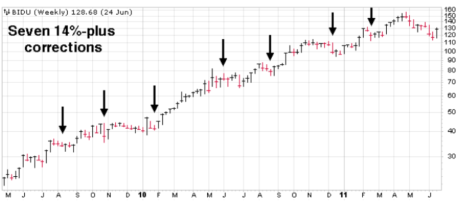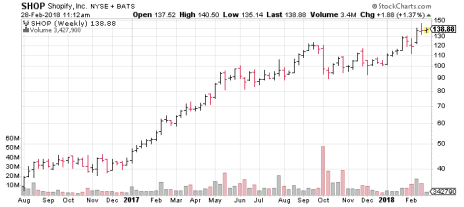Some stocks in the Model Portfolio and others we’ve recommended have had great runs during 2017 but have come under pressure at the beginning of 2018. And that’s naturally led to a lot of questions about exactly how to handle winning stocks, so that’s what we’ll dive into today.
First off, there’s no one perfect way to handle big winners; if there was, then nobody would ever get shaken out and everyone would sell at the top. That’s not going to happen! But keeping three facts in mind will help.
How to Handle Winning Stocks: Fact #1
As a growth investor, grabbing a few big winners is key to your long-term success. That’s because it’s difficult to make much upside progress if you’re taking only 15% or 20% profits; those singles eventually get eaten away by small losses (and the occasional loser that gets away from you on, say, an earnings gap). Growth investing tends to be skewed, with a lot of your net profit coming from a relatively few trades.
[text_ad]
How to Handle Winning Stocks: Fact #2
Even the best winners are going to have a bunch of scary corrections and tedious sideways periods during their advances. You can use almost any example, but look at Baidu (BIDU), which we bought in July 2009 and rode for more than two years. Our total profit was 283%, but during its upmove, BIDU had seven pullbacks of at least 14% (see chart). In other words, you’re going to have to take plenty of heat during a big winner’s advance.
How to Handle Winning Stocks: Fact #3
Big moves take time to play out. For a stock to run 100%, 200% or more, it’s going to take many months if not longer as institutional investors build positions.
Combining all three, we believe that (a) when you catch a tiger by the tail, you want to try to get as much as you can out of it, but (b) you must use a system that gives you conviction and gives the stock room to correct and consolidate along its way higher while also (c) having an idea of where the stock is within its longer-term advance.
That’s why we advise using our “tight-to-loose” system, which means we start out with a relatively tight loss limit but then gradually loosen our mental stop as the stock advances. Ideally, if we have a big enough profit, we like to simply ride the stock’s 200-day moving average, which usually contains most big winners’ major upmoves. We also frequently (though not always) take partial profits on the way up, which not only books some profit but allows us more conviction in giving our remaining shares more rope.
On the flip side, there are a couple of things we don’t advise. One is to sell all your shares on the way up. We like booking profits as much as anyone, but telling a wining stock it can’t go any higher can prove very painful if you really do have a true market leader.
We’d also be careful selling a stock with the goal of buying it back later. Such a consolidation might not come for a while, and even if it does, buy points are not always clean-cut. We’ve often seen investors sell out entirely, and then suffer two or three losing trades when trying to re-enter, and then move on … often just before the stock resumes its longer-term uptrend.
My Biggest 2017 Winner
Let’s apply these various do’s and don’ts to Shopify (SHOP), our biggest winner in the Model Portfolio last year. The stock broke out of a huge IPO base last January, which was our signal to jump on board; it doubled by June and, after a reasonable consolidation, lifted as high as 124 in September. Then came some weakness in growth stocks and a high-profile attack by a well-known short seller. The result: A sharp 28% correction.
Was the run over? It was possible (we sold some shares during the retreat), but certainly not conclusive—SHOP was still above its long-term 40-week moving average (which we try to use once we have a big winner). And, importantly, the stock began to find support the week after its initial dip. Thus, despite no net progress from June through December, we held onto our remaining shares—and this year, the stock has come alive, regaining its leadership status.
Of course, if SHOP fell from here and stopped us out in, say, the mid 100s, that wouldn’t be great (to say the least). But our experience tells us that giving this type of situation plenty of room usually allows us to sit through a normal correction and benefit from the stock’s longer-term uptrend. That’s what’s happened so far, and that’s where the big money is earned.
For further updates on SHOP and other stocks that I hold in my Cabot Growth Investor portfolio, consider joining us today.
[author_ad]
This post is updated from its original version published in 2017.



